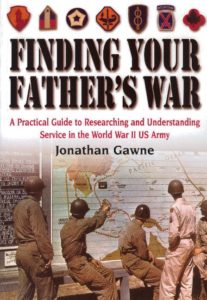 Finding Your Father’s War: A Practical Guide to Researching and Understanding Service in the World War II US Army. By Jonathan Gawne. Softbound (2006), 256 pp., illus., indexed, $24.95, plus $6.00 US shipping. Published by Casemate, 1016 Warrior Rd., Drexel Hill, PA 19026; tel.: 610-853-9131.
Finding Your Father’s War: A Practical Guide to Researching and Understanding Service in the World War II US Army. By Jonathan Gawne. Softbound (2006), 256 pp., illus., indexed, $24.95, plus $6.00 US shipping. Published by Casemate, 1016 Warrior Rd., Drexel Hill, PA 19026; tel.: 610-853-9131.
Review by James Pylant
“The reason for wanting to trace someone’s service in World War II comes from a desire to gain an understanding of what they went through, with an eye toward catching a glimpse of the horror, boredom, or endless frustration that is war,” the author writes in the introduction. Jonathan Gawne, a noted military historian and researcher, is the son of a World War II veteran. However, it was not until his father’s death that Gawne had what he admits to even a fraction of an understanding of what he had experienced. The author’s search—and reconstruction—of the events of his father’s war years is what eventually led to Finding Your Father’s War as a guide.
A profusely illustrated guide, Gawne’s book breaks the subject into five sections. The first, an introduction to army units gives a background on the composition of World War II US Army—rank, enlisted men, officers, warrant officers, and branches of service. The second section is about individual records and explains serial numbers, the army serial number database, dog tags, service records, army mail, discharge, and death records.
Every unit in the army had to keep records of its activities, and this is the topic of the third section—organizational records—which discusses classified materials, company records, code names, and unit histories. Of special interest to genealogists is the fourth section: finding records. The Freedom of Information Act, the photographic, motion picture, and cartographic collections of the National Archives, the National Personnel Records Center (NPRC), and official army military sources are among the topics covered.
“Members of the military carry their service history around with them as if wearing a resume on their chest,” the author points out. The fifth section explains uniforms and insignia is helpful when a researcher has tangible evidence of a relative’s military service, such as a patch or a part of a uniform.
Appendices cover the infantry and airborne divisions, the armored and cavalry divisions, army groups, armies and corps; major army commands, the army air forces, vehicle markings; the campaigns, official abbreviations, and the Green Books and selected biography.
Gawne’s knowledge of World War II US Army research is impressive. His attention to detail and suggestions for seeking information make Finding Your Father’s War an invaluable aid.
Finding Your Father’s War : A Practical Guide to Researching and Understanding Service in the World War II Us Army is also available from Amazon.com (affiliate link).
Book Review and Material Connection Disclosure: GenealogyMagazine.com receives complimentary copies of books with the understanding that they will be considered for review without compensation. Some of the links published on this site are “affiliate links,” meaning that if a site user clicks on the link and purchase the item, GenealogyMagazine.com will receive an affiliate commission. Regardless, we will only recommend products or services that we would personally use and believe will add value to our readers. We are disclosing this in accordance with the Federal Trade Commission’s 16 CFR, Part 255: “Guides Concerning the Use of Endorsements and Testimonials in Advertising.”
